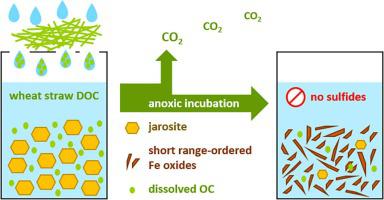Geoderma ( IF 5.6 ) Pub Date : 2022-04-19 , DOI: 10.1016/j.geoderma.2022.115875 Angelika Kölbl 1 , Klaus Kaiser 1 , Aaron Thompson 2 , Luke Mosley 3 , Rob Fitzpatrick 3 , Petra Marschner 4 , Leopold Sauheitl 5 , Robert Mikutta 1

|
When acid sulfate soils dry, oxidation of pyrite can cause acidification and formation of iron (Fe) oxyhydroxy sulfate phases such as jarosite. Remediation via re-establishment of reducing conditions requires submergence and addition of biodegradable organic carbon (OC) to stimulate activity of reducing bacteria. Addition of fresh plant litter has been shown to activate reducing bacteria, likely due to the release of readily available soluble organic matter. However, the effectiveness of soluble organic matter from plant residues has not been tested yet. Here, we tested the potential of wheat straw-derived dissolved OC (DOC) for remediation of a sandy sulfuric (pH < 4) soil. In a second set of experiments, we used combinations of wheat straw-derived DOC with lactate, which is a preferred substrate of sulfate reducing bacteria. All incubation experiments were conducted in the dark at 20 °C. The results showed that addition of DOC from wheat straw induces reduction reactions and rapidly increases the pH by 2–3 units after 3 weeks of incubation under submerged conditions. Mössbauer spectroscopy and X-ray diffraction revealed that jarosite was lost after 200 days of anoxic incubation. Short range-ordered FeIII oxyhydroxides were formed, most likely by FeII-catalysed transformation of jarosite. A second addition of DOC, as well as the addition of lactate, resulted in the almost complete loss of jarosite with increased proportions of FeIII oxyhydroxides in the remaining solids, but not in the formation of FeII sulfides. The formation of FeIII oxyhydroxides reduces the risk of both Fe leaching and renewed acidification in the event of future oxidation. The results suggest that deep injection of wheat straw-derived DOC is a promising approach for rapid and sustainable remediation of sandy sulfuric subsoils.
中文翻译:

利用秸秆衍生的溶解有机物快速修复沙质硫磺底土
当酸性硫酸盐土壤干燥时,黄铁矿的氧化会导致酸化并形成铁 (Fe) 羟基硫酸盐相,例如黄钾铁矾。通过重建还原条件进行修复需要浸没并添加可生物降解的有机碳 (OC) 以刺激还原细菌的活性。已显示添加新鲜植物垫料可激活还原细菌,这可能是由于释放了容易获得的可溶性有机物。然而,尚未测试植物残留物中可溶性有机物的有效性。在这里,我们测试了小麦秸秆衍生的溶解有机碳 (DOC) 修复沙质硫酸 (pH < 4) 土壤的潜力。在第二组实验中,我们使用了小麦秸秆衍生的 DOC 与乳酸的组合,乳酸是硫酸盐还原细菌的首选底物。所有孵育实验均在 20°C 的黑暗中进行。结果表明,在浸没条件下孵育 3 周后,从小麦秸秆中添加 DOC 会诱导还原反应并迅速将 pH 值提高 2-3 个单位。穆斯堡尔光谱和 X 射线衍射表明黄钾铁矾在缺氧培养 200 天后丢失。短程有序铁III羟基氧化物的形成很可能是通过 Fe II催化黄钾铁矾的转化。第二次添加 DOC 以及添加乳酸导致黄钾铁矾几乎完全丧失,剩余固体中 Fe III羟基氧化物的比例增加,但不形成 Fe II硫化物。Fe III羟基氧化物的形成降低了 Fe 浸出和在未来氧化事件中重新酸化的风险。结果表明,深注入小麦秸秆衍生的 DOC 是一种有前景的快速和可持续修复沙质硫酸底土的方法。











































 京公网安备 11010802027423号
京公网安备 11010802027423号